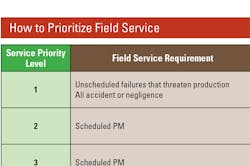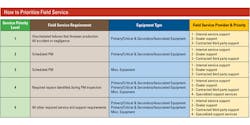Don't Let Field Service Affect Productivity
Field services support a fleet’s ability to keep equipment on location and productive throughout the project duration. On-site services such as fueling, lubrication, cleaning, scheduled preventive maintenance (PM), unscheduled diagnostics, and repairs are vital to maximize equipment productivity and maintain economical equipment cost.
Field service staff effectively maintain the equipment and reduce unscheduled equipment downtime and cost. Unscheduled downtime reduces revenue, increases project delay concerns, and increases equipment tangible and intangible cost. Tangible costs of unscheduled downtime include lost revenue, transportation costs, temporary rental of additional equipment, and staff overtime. Intangible costs include lost productivity, delays in meeting project delivery schedules, and disruptions in workflow process.
Field services are a key extension of the maintenance functions’ area of responsibility, and equipment managers must closely coordinate with operators and operational staff to meet their needs and expectations. Operators and operational staff expect equipment to arrive on site thoroughly inspected, serviced, and free of defects. On-site, comprehensive field service capability ensures maximum utilization and reduces downtime, transportation, and secondary equipment costs of transporting the equipment to the shop for maintenance and repair.
A strategic service plan ensures understanding and coordination among operations, field staff, and contracted support services.
Larger projects might require an on-site service technician to perform scheduled PM service and immediately address unscheduled defects. Smaller projects rely upon field services dispatched from the maintenance facility and other service suppliers to support these service functions. On projects large and small, however, several field service technicians from the various resources could be on site at any given time, compounding the need for focused field service management.
Equipment managers must address the scheduled and unscheduled challenges of field service on a daily basis as it involves complexities above those encountered with services provided within the maintenance facility. The size and scope of the organization, its operating territory, parts availability, and remote locations create the need for intense focus, coordination, and communication. Continued operational expectations for increased serviceability, increased technical complexity of today’s equipment, and the intense competition for future projects continue to pressure even the best-run organizations to elevate their field service support capabilities.
Proactive equipment managers address these challenges through the establishment of a pre-determined strategic field service and support plan. Understanding the multitude of field service requirements, they develop and coordinate with operations a defined field service priority level for all equipment types and identify all resources available to address these challenges.
Establishing a pre-determined repair priority level plan is an invaluable resource in managing field service support. Repair priorities are developed through frequent communications with operational managers and are established to identify the organization’s field services priority process. Key elements in developing the process are inclusion of all equipment types, scheduled service grace periods (windows), and failure notification timeliness.
The table below shows a five-level priority approach to address most field service requirements:
1st: Equipment that has experienced an unscheduled failure which without it inhibits or threatens production. This includes all primary/critical and secondary/associated equipment deployed on site. Unscheduled failure/breakdown due to accident or potential negligence becomes primary to complete timely incident investigation report.
2nd: All scheduled PM services required by primary/critical and secondary/associated equipment deployed on site.
3rd: All scheduled PM services on miscellaneous equipment deployed on site.
4th: Required repairs identified during PM inspection that could possibly develop into a larger repair or unscheduled failure or left deferred.
5th: All other required service and support requirements.
Resources available to successfully support field service include internal service support, dealer support services, third-party service suppliers, and other highly specialized support services. The capabilities of each should be frequently reviewed and well documented. Internal and service provider workload, technicality of services required, location, technician availability, skills, abilities, and potential warranty concerns are all considerations in determining the service provider to be dispatched.
The organization’s technician staff is the first line of field service support. Internal technicians are easily scheduled and dispatched, have the technical capabilities and parts required to perform routine scheduled and unscheduled maintenance services, and are the most cost-effective.
Dealer support services become valuable where location and travel distances inhibit the efficiencies of internal service and support. Equipment dealers normally can quickly respond whether service is scheduled or unscheduled. Qualified technicians have the technical capability and parts required to perform the services required. Dealer and OEM service representatives are up to date on service bulletins, diagnostics, and techniques required to properly return equipment to service. Third-party contractual services are available for most equipment requirements on a specific project or in an operational region. Contracted services may not have all the technical capabilities or resources as internal or dealer services, but, they are a resource, especially for remote location service and support. Third-party services should be considered at the beginning of a project to support routine services such as fuel and lube to increase shift and machine productivity.
Support services from highly specialized repair/rebuild suppliers should be included where specialized components are uneconomical to service or repair in the field. Electrical and computerized components and highly specialized mounted equipment are easily managed by these providers.
A pre-determined strategic field service and support plan increases understanding and coordination among operations managers, field staff, and contracted support services. Compliance with service schedules will increase, allowing equipment managers to better schedule and balance resources to meet their goal of reducing unscheduled downtime and cost.
Click here for more on asset management.

